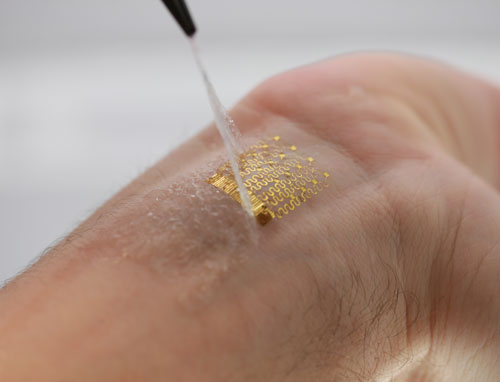| Posted: Dec 09, 2013 | |
Electronic skin takes your temperature |
|
| (Nanowerk Spotlight) Previous work in stretchable, flexible electronics has shown that conventional, silicon wafer based fabrication techniques can be modified to apply electronics conformally to the heterogeneous topography of the skin (in a recent Nanowerk Spotlight we covered design considerations and recent progress in the development of electronic skin). | |
| Additionally, previous work in medical thermal imaging has shown the utility of precision temperature mapping of human skin in the study of pathological conditions that affect how the body regulates temperature. | |
| However, medical thermal imaging suffers from the high cost of infrared cameras (>$100,000 for high-precision models), and the cameras struggle to measure curved or moving surfaces of living tissues. | |
| An international multidisciplinary team including researchers at the University of Illinois at Urbana-Champaign and the National Institute of Biomedical Imaging and Bioengineering (NIBIB) has extended ideas from these previous works to enable continuous mapping the temperature of curved, moving skin – or other tissue – to a precision better than 0.02 °C, that can be manufactured for pennies. | |
| Reporting their results in a recent issue of Nature Materials ("Ultrathin conformal devices for precise and continuous thermal characterization of human skin"), the team demonstrates the development of a device platform that enables high precision temperature mapping of the skin in ways that have, until now, been extremely difficult in research and impossible to implement for widespread use. | |
 |
|
| Image of a 4x4 sensor array after application to the skin using a water-soluble adhesive tape based on poly(vinyl alcohol). (Image: Rogers Research Group, University of Illinois at Urbana-Champaign) | |
| "Our findings extend previously demonstrated ideas in ultrathin skin-mounted electronics to real, medically relevant applications that benefit from high precision thermal mapping and heating," John A. Rogers, Professor of Materials Science and Engineering, and Director, F. Seitz Materials Research Laboratory, at the University of Illinois at Urbana-Champaign, tells Nanowerk. "Our advancement to the field is two-fold: 1) the fabrication schemes and thermal and mechanical modeling lay a groundwork of information that will be relevant to the future development of stretchable and/or biointegrated electronics where temperature or heat generation is a concern, and 2) the devices we have demonstrated enable a new avenue in medicine for investigating the minute temperature signals, as well as responses to heat, that relate to human physiology." | |
| The temperature sensor array is a variation of a novel technology, originally developed in Rogers' lab, called epidermal electronics, consisting of ultrathin, flexible skin-like arrays, which resemble a tattoo of a micro-circuit board (see for instance: "Electronic sensing with your fingertips"). | |
| The devices incorporate microscale temperature sensors that can simultaneously act as micro-heaters (actuators), in arrayed layouts on thin, low modulus elastic sheets. The sensors/actuators rely on either thin serpentine features of 50nm thin gold layers or PIN diodes formed by patterned doping of 320 nm thick silicon nanomembranes. | |
| In their experiments, the researchers tested their 'diagnostic skin' against measurements by an infrared camera, the 'gold standard' in measuring localized skin temperature. In all cases, both methods resulted in virtually identical results. | |
| Rogers notes that the most direct applications of this work will be in future research on continuous, precise temperature mapping and localized heating of human skin. Examples include continuous monitoring of healing wounds, new studies in minute temperature oscillations due to various diseases, and thermally-activated delivery of drugs through tissue. | |
| "These represent a few areas of interest for us, but we hope that the technology developed leads to more new medical research and applications than we could hope to accomplish on our own," he says. | |
| Currently, the biggest challenge for this form of ultrathin skin-mounted electronics is to make them completely wireless. This requires both wireless data transmission, as well as wireless power generation in the device. Various ideas have been presented to solve these problems at a basic level, but nothing yet has provided a solution that would enable the precise mapping capabilities shown here in a format that conforms to the skin and is completely wireless. This is an active area of research for Rogers' group, and others, that they hope to improve on continuously in the coming years. | |
| Future directions in this field of stretchable, biointegrated electronics include more advanced circuitry in stretchable formats to enable more complex health monitoring, electronics that can be designed to resorb into the body after a certain amount of time, and advanced electronic surgical devices that are not limited to rigid plastic or metal tools. | |
| Rogers points out that converting silicon wafer based electronics to stretchable, biocompatible formats is challenging and requires a very different approach to almost every level of device design than is typical in electronics. "However, the problems are solvable and we expect a continuous road of development moving forward." | |
 By
Michael
Berger
– Michael is author of three books by the Royal Society of Chemistry:
Nano-Society: Pushing the Boundaries of Technology,
Nanotechnology: The Future is Tiny, and
Nanoengineering: The Skills and Tools Making Technology Invisible
Copyright ©
Nanowerk LLC
By
Michael
Berger
– Michael is author of three books by the Royal Society of Chemistry:
Nano-Society: Pushing the Boundaries of Technology,
Nanotechnology: The Future is Tiny, and
Nanoengineering: The Skills and Tools Making Technology Invisible
Copyright ©
Nanowerk LLC
|
|
|
Become a Spotlight guest author! Join our large and growing group of guest contributors. Have you just published a scientific paper or have other exciting developments to share with the nanotechnology community? Here is how to publish on nanowerk.com. |
|
